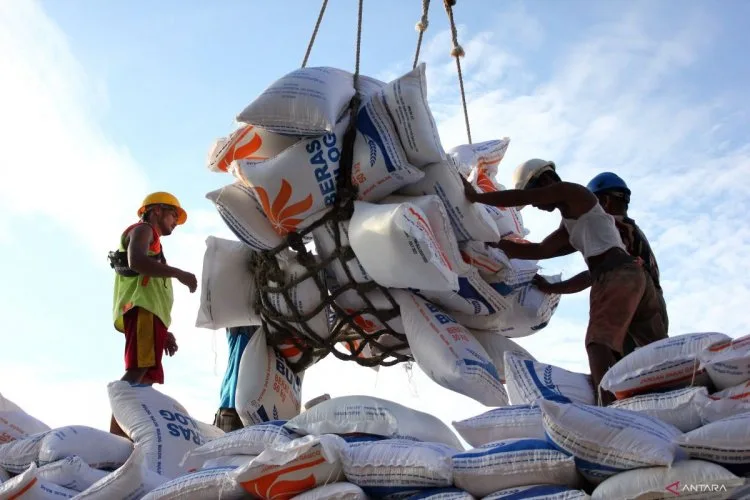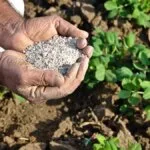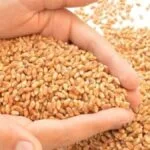Main Points In Hindi (मुख्य बातें – हिंदी में)
-
चावल उत्पादन में गिरावट: इंडोनेशिया का 2024 में चावल उत्पादन पिछले वर्ष की तुलना में 2.43% घटकर 30.34 मिलियन मीट्रिक टन होने का अनुमान है, जो लंबे समय तक शुष्क मौसम के कारण रोपण और कटाई में हुई देरी से प्रभावित है।
-
आयात की योजना: देश अपनी चावल की घरेलू आपूर्ति को सुरक्षित रखने के लिए 2025 में भारत से 1 मिलियन मीट्रिक टन चावल आयात करने पर विचार कर रहा है, क्योंकि उत्पादन में कमी से देश को अतिरिक्त चावल की आवश्यकता है।
-
चावल की बढ़ती मांग: इंडोनेशिया के 280 मिलियन नागरिकों की चावल की वार्षिक मांग के चलते, पिछले दो वर्षों में चावल के आयात में उल्लेखनीय वृद्धि हुई है, जो अब सालाना 30 लाख मीट्रिक टन से अधिक हो गया है।
-
कृषि क्षेत्र का विस्तार: इंडोनेशियाई सरकार ने अगले 3-4 वर्षों में 3 मिलियन हेक्टेयर नए चावल क्षेत्र विकसित करने की योजना बनाई है, जिससे खाद्य आत्मनिर्भरता को बढ़ावा दिया जा सके।
- विदेशी स्रोतों से आपूर्ति के लिए खुलापन: इंडोनेशिया ने अपनी राज्य खरीद एजेंसी, बुलॉग के माध्यम से भारतीय चावल के आयात के लिए द्वार खोला है, जिससे आने वाले निविदाओं में भारतीय चावल की पेशकश की जा सकेगी।
Main Points In English(मुख्य बातें – अंग्रेज़ी में)
Here are the main points from the provided text regarding Indonesia’s rice production and import plans:
-
Decline in Rice Production: Indonesia’s rice production is projected to decrease by 2.43% in 2024, reaching approximately 30.34 million metric tons. This decline is attributed to prolonged dry weather and delays in planting and harvesting seasons.
-
Import Plans for 2025: To secure its domestic rice supply amidst production delays, Indonesia is considering importing 1 million metric tons of rice from India in 2025. This decision is in response to anticipated lower production due to ongoing dry conditions.
-
Increasing Demand and Importation: With an annual rice demand of 280 million citizens, Indonesia has been increasing its rice imports, which have risen to over 3 million metric tons annually in the past two years. This year, it aims to import 3.6 million tons of rice.
-
Government Initiatives: The Indonesian government plans to create 3 million hectares of new rice fields over the next 3-4 years to meet food self-sufficiency goals set by President Prabowo Subianto.
- Openness to Indian Rice: Indonesia’s state purchasing agency, Bulog, has signaled a willingness to source Indian rice for its future tenders, especially after India relaxed its export restrictions, making Indian rice more competitive in the international market.


Complete News In Hindi(पूरी खबर – हिंदी में)
देश के सांख्यिकी ब्यूरो के अनुसार, इंडोनेशिया का 2024 चावल उत्पादन पिछले वर्ष से 2.43% गिरकर 30.34 मिलियन मीट्रिक टन तक पहुंचने का अनुमान है। यह गिरावट लंबे समय तक शुष्क मौसम के बीच रोपण और कटाई के मौसम में देरी के प्रभाव को दर्शाती है।
इंडोनेशिया फसल में देरी के बीच अपनी घरेलू आपूर्ति को सुरक्षित रखने के लिए 2025 में भारत से 1 मिलियन मीट्रिक टन चावल आयात करने पर विचार कर रहा है। इंडोनेशिया बिजनेस पोस्ट की रिपोर्ट के अनुसार, खाद्य मामलों के समन्वय मंत्री जुल्किफली हसन ने मंगलवार को एक अंतर-मंत्रालयी बैठक के बाद यह बात कही। प्रस्तावित आयात 2025 की शुरुआत में अनुमानित कम उत्पादन की प्रतिक्रिया है, जो लंबे समय तक शुष्क मौसम के कारण रोपण और कटाई के मौसम में देरी से प्रेरित है।
राष्ट्रीय खाद्य एजेंसी के प्रमुख, एरीफ प्रासेत्यो आदि ने तात्कालिकता के बारे में बताते हुए कहा, ‘हमें फरवरी तक अतिरिक्त 1 मिलियन टन की आवश्यकता है।’ उन्होंने कहा कि दिसंबर और फरवरी के बीच उत्पादन आमतौर पर कम होता है, जिससे कमी बढ़ जाती है।
देश के सांख्यिकी ब्यूरो के अनुसार, इंडोनेशिया का 2024 चावल उत्पादन पिछले वर्ष से 2.43% गिरकर 30.34 मिलियन मीट्रिक टन तक पहुंचने का अनुमान है। यह गिरावट लंबे समय तक शुष्क मौसम के बीच रोपण और कटाई के मौसम में देरी के प्रभाव को दर्शाती है।
इंडोनेशिया के 280 मिलियन नागरिकों की वार्षिक चावल की मांग के साथ, देश ने इस अंतर को भरने के लिए पहले ही अंतरराष्ट्रीय स्रोतों की ओर रुख कर लिया है। पिछले दो वर्षों में चावल के आयात में उल्लेखनीय वृद्धि हुई है, जो सालाना 30 लाख मीट्रिक टन से अधिक हो गया है।
इंडोनेशिया इस वर्ष 3.6 मिलियन टन चावल के आयात का लक्ष्य बना रहा है। इस बीच, सरकार ने राष्ट्रपति प्रबोवो सुबिआंतो के खाद्य आत्मनिर्भरता लक्ष्य को प्राप्त करने के लिए अगले 3-4 वर्षों में 3 मिलियन हेक्टेयर नए चावल क्षेत्र बनाने की भी योजना बनाई है।
बढ़ते व्यापार के अवसर को जोड़ते हुए, भारत ने हाल ही में निर्यात प्रतिबंधों में ढील दी है। बंपर पैदावार के जवाब में, भारत ने गैर-बासमती चावल शिपमेंट के लिए न्यूनतम मूल्य हटा दिया है और उबले और भूसी (भूरे) चावल को निर्यात शुल्क से छूट दे दी है, जिससे भारतीय चावल अंतरराष्ट्रीय बाजार में अधिक प्रतिस्पर्धी बन गया है।
हाल ही में, इंडोनेशिया की राज्य खरीद एजेंसी, बुलॉग ने एक विस्तारित सोर्सिंग रणनीति का संकेत दिया। प्रारंभ में, 340,000 मीट्रिक टन चावल खरीदने के लिए बुलॉग की निविदा में केवल थाईलैंड, कंबोडिया, वियतनाम या पाकिस्तान से आपूर्ति की अनुमति थी। हालांकि, मंगलवार को व्यापारियों को भेजे गए एक नोटिस में कहा गया है कि भारतीय मूल के चावल की भी पेशकश की जा सकती है, जो आगामी निविदाओं में भारतीय चावल के लिए इंडोनेशिया के खुलेपन का संकेत देता है।
पिछले पांच वर्षों में इंडोनेशिया के राष्ट्रीय चावल उत्पादन में गिरावट आई है। कीट और बीमारी के हमलों और अल नीनो घटना सहित जलवायु परिवर्तन से जुड़ी प्राकृतिक आपदाओं के कारण फसल की विफलता के अलावा, कृषि भूमि के सिकुड़ने से गिरावट को और बढ़ावा मिला है।”
Complete News In English(पूरी खबर – अंग्रेज़ी में)
According to the country’s statistics bureau, Indonesia’s rice production in 2024 is expected to drop by 2.43% from the previous year, reaching 30.34 million metric tons. This decline is attributed to delays in planting and harvesting due to prolonged dry weather.
To secure its domestic supply amid crop delays, Indonesia is considering importing 1 million metric tons of rice from India in 2025. This was announced by the Minister of Food Affairs, Zulkifli Hasan, following an inter-ministerial meeting. The proposed import is a response to the anticipated low production at the beginning of 2025, influenced by delayed planting and harvesting caused by dry conditions.


Arief Prasetyo, head of the National Food Agency, emphasized the urgency, stating, “We need an additional 1 million tons by February.” He noted that production typically decreases between December and February, exacerbating shortages.
With a rice demand of 280 million citizens, Indonesia has turned to international sources to fill the gap. Over the past two years, rice imports have significantly increased, now exceeding 3 million metric tons annually.
This year, Indonesia aims to import 3.6 million tons of rice. Additionally, the government plans to establish 3 million hectares of new rice fields in the next 3-4 years to meet President Prabowo Subianto’s goal of food self-sufficiency.
To enhance trade opportunities, India has recently eased export restrictions. In response to a bumper crop, India has removed the minimum price for non-basmati rice shipments and exempted boiled and husked rice from export duties, making Indian rice more competitive in the international market.
Recently, Indonesia’s state buying agency, Bulog, indicated a broader sourcing strategy. Initially, Bulog’s tender for purchasing 340,000 metric tons of rice allowed supply only from Thailand, Cambodia, Vietnam, or Pakistan. However, a notice sent to traders on Tuesday revealed that Indian rice can also be offered, signaling Indonesia’s openness to Indian rice in upcoming tenders.
In the past five years, Indonesia’s national rice production has declined. Factors contributing to this decrease include pests, diseases, and natural disasters related to climate change, along with the reduction of agricultural land.
Source link


 By
By 



